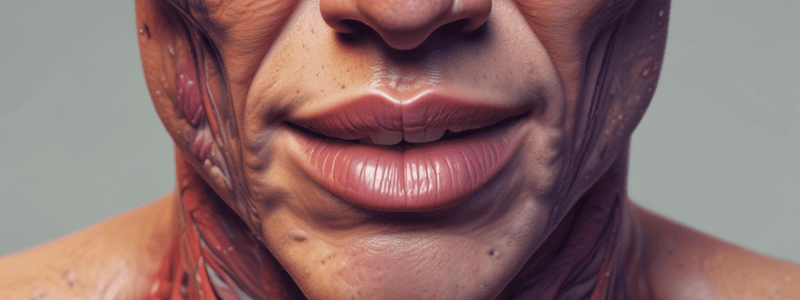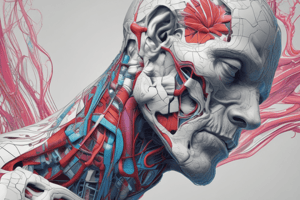Podcast
Questions and Answers
What is the function of the eyelids in the human body?
What is the function of the eyelids in the human body?
- To provide facial structure
- To aid in hearing
- To help with vision
- To cover the eyes for protection (correct)
Where are the teeth, gums, and tongue located?
Where are the teeth, gums, and tongue located?
- In front of the cervical vertebrae
- Inside the ears
- In the oral cavity inside the mouth (correct)
- On top of the head
Which part of the human body connects the head to the trunk?
Which part of the human body connects the head to the trunk?
- Neck (correct)
- Cheeks
- Ears
- Forehead
What is the main function of the neck in the human body?
What is the main function of the neck in the human body?
Which part of the human body is described as 'corpulent'?
Which part of the human body is described as 'corpulent'?
Where is the brain located in the human body?
Where is the brain located in the human body?
Which part of the human body is covered with hair at the back?
Which part of the human body is covered with hair at the back?
What is formed by two jaws, one immobile and one mobile?
What is formed by two jaws, one immobile and one mobile?
What organ connects the head to the trunk?
What organ connects the head to the trunk?
How many parts is the human trunk composed of?
How many parts is the human trunk composed of?
Where is the thorax located in the human body?
Where is the thorax located in the human body?
Which organs are included in the thoracic cavity?
Which organs are included in the thoracic cavity?
What separates the abdominal cavity from the thoracic cavity?
What separates the abdominal cavity from the thoracic cavity?
How many toes does each foot have?
How many toes does each foot have?
What connects the arm with the forearm in the upper extremities?
What connects the arm with the forearm in the upper extremities?
In which region of the pelvic cavity are reproductive organs located in females?
In which region of the pelvic cavity are reproductive organs located in females?
What kind of joints connect the thigh, leg, and foot in the lower extremities?
What kind of joints connect the thigh, leg, and foot in the lower extremities?
What is an organ made up of?
What is an organ made up of?
What comprises all tissues of the body according to the text?
What comprises all tissues of the body according to the text?
What are the two main structures that make up most organs?
What are the two main structures that make up most organs?
Which type of tissue is closely packed with little ground-substance?
Which type of tissue is closely packed with little ground-substance?
Which tissue has ground substance that is more important than the cells that produce it?
Which tissue has ground substance that is more important than the cells that produce it?
How many types of highly specialized muscle cells are described in the text?
How many types of highly specialized muscle cells are described in the text?
From which embryonic layer does nervous tissue arise?
From which embryonic layer does nervous tissue arise?
What is the role of the stroma in an organ?
What is the role of the stroma in an organ?
Which tissue forms the whole nervous system?
Which tissue forms the whole nervous system?
What is the main function of the parenchyma in an organ?
What is the main function of the parenchyma in an organ?
Which tissue has the most ground substance compared to cells?
Which tissue has the most ground substance compared to cells?
What is the main function of the stroma in an organ?
What is the main function of the stroma in an organ?
Match the following types of tissue with their description:
Match the following types of tissue with their description:
Match the following tissue components with their roles:
Match the following tissue components with their roles:
Match the following muscular cell types with their descriptions:
Match the following muscular cell types with their descriptions:
Match the following organ structures with their composition:
Match the following organ structures with their composition:
Match the following embryonic tissue origins with their adult function:
Match the following embryonic tissue origins with their adult function:
Match the following body parts with their locations:
Match the following body parts with their locations:
Match the following organs with their respective cavities:
Match the following organs with their respective cavities:
Match the following joints with the body segments they connect:
Match the following joints with the body segments they connect:
Match the following body parts with their descriptions:
Match the following body parts with their descriptions:
Match the following tissue types with their descriptions:
Match the following tissue types with their descriptions:
Match the following body parts with their descriptions:
Match the following body parts with their descriptions:
Match the following facial features with their descriptions:
Match the following facial features with their descriptions:
Match the following skull parts with their locations:
Match the following skull parts with their locations:
Match the following jaw-related terms with their descriptions:
Match the following jaw-related terms with their descriptions:
Match the following cavity descriptions with their contents:
Match the following cavity descriptions with their contents:
Match the following body parts with their descriptions:
Match the following body parts with their descriptions:
Match the following facial features with their descriptions:
Match the following facial features with their descriptions:
Match the following skull parts with their locations:
Match the following skull parts with their locations:
Match the following jaw-related terms with their descriptions:
Match the following jaw-related terms with their descriptions:
Match the following cavity descriptions with their contents:
Match the following cavity descriptions with their contents:
Match the following main tissue types with their examples:
Match the following main tissue types with their examples:
Match the following tissue components with their characteristics:
Match the following tissue components with their characteristics:
Match the following organ structures with their composition:
Match the following organ structures with their composition:
Match the following cell types with muscular tissues:
Match the following cell types with muscular tissues:
Match the following embryonic origin tissues with their adult forms:
Match the following embryonic origin tissues with their adult forms:
Match the following body regions with their descriptions:
Match the following body regions with their descriptions:
Match the following extremities with their segments:
Match the following extremities with their segments:
Match the following joints with the body parts they connect:
Match the following joints with the body parts they connect:
Match the following cavities with their contents:
Match the following cavities with their contents:
Match the following body parts with their regions:
Match the following body parts with their regions:
Match the following tissue components with their roles:
Match the following tissue components with their roles:
'Match the following cell types with their characteristics:
'Match the following cell types with their characteristics:
'Match the following organ components with their composition:
'Match the following organ components with their composition:
'Match the following organ structures with their function:
'Match the following organ structures with their function:
'Match the following joints with their functions:
'Match the following joints with their functions:
Flashcards are hidden until you start studying




